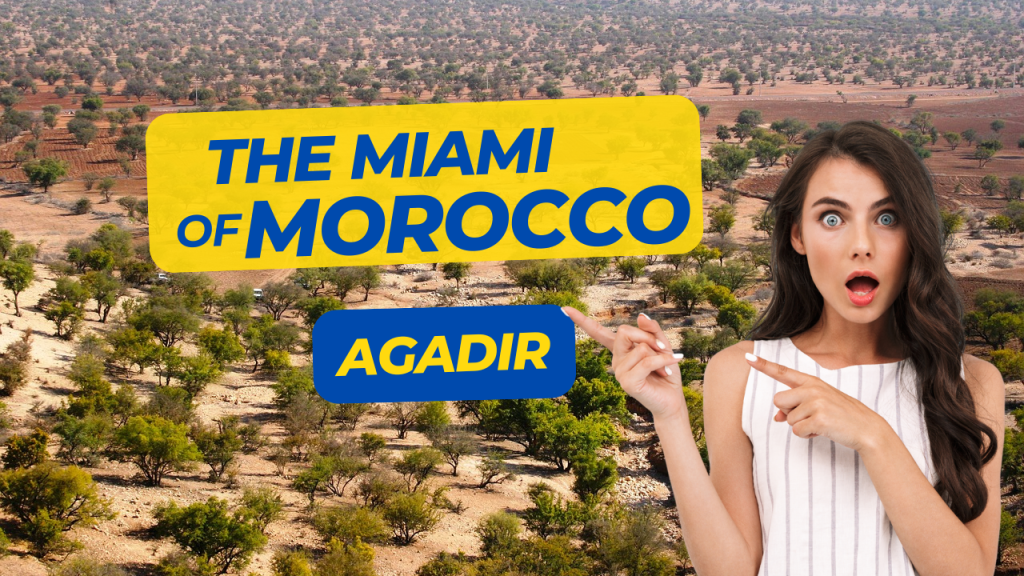Agadir, often dubbed the “Miami of Morocco,” stands as a vibrant testament to modern resilience and timeless allure on Morocco’s sun-drenched Atlantic coast. Rebuilt with contemporary urban planning after a devastating earthquake in 1960, Agadir has blossomed into a premier tourist destination, blending traditional Moroccan hospitality with a distinctly European resort feel. Its appeal lies in its year-round sunshine, a magnificent crescent-shaped beach stretching over 10 kilometers, and a diverse array of activities that cater to every traveler, from families seeking relaxation to adventurers yearning for thrills.
The Golden Sands and Azure Waters: Agadir’s Coastal Charm
At the heart of Agadir’s tourism lies its spectacular beach. This expansive stretch of golden sand, gently lapped by the Atlantic’s calm waters, is the city’s undisputed crown jewel. Unlike some of Morocco’s more rugged coastlines, Agadir’s main beach is sheltered, making it ideal for swimming, sunbathing, and leisurely strolls along its well-maintained promenade. The corniche, a lively boardwalk extending for miles, is a hub of activity, lined with cafes, restaurants, and shops, perfect for people-watching or enjoying a sunset cocktail.
Beyond the main city beach, the surrounding region boasts a collection of equally enticing coastal spots. To the north, the charming fishing villages of Taghazout and Tamraght have gained international acclaim as surfing meccas. Their consistent waves draw surfers of all levels, from beginners eager to catch their first wave to seasoned pros tackling challenging breaks like Anchor Point and Killer Point. Numerous surf schools and rental shops cater to this vibrant community, offering lessons and gear for all. Further north, lesser-known gems like Aourir (Banana Beach) and Imourane offer more tranquil settings and a taste of local life, while the picturesque Imsouane, located on a dramatic coastal tip, is renowned for its long waves and laid-back surf culture.
Water sports are an integral part of the Agadir experience. Beyond surfing, the Atlantic’s consistent winds create excellent conditions for windsurfing and kitesurfing. For those seeking a more adrenaline-fueled experience, jet skiing and parasailing are readily available along the main beach. Boat tours provide a different perspective of the coastline, often including stops at secluded coves and opportunities for wildlife spotting, including dolphins and seabirds. Deep-sea fishing excursions also attract enthusiasts hoping to reel in a big catch.
A City Reborn: Modernity and Heritage
While Agadir’s history stretches back centuries, the devastating earthquake of 1960 fundamentally reshaped its urban landscape. The city rose from its ruins with a modern design, wider avenues, and seismic-resistant architecture. This has given Agadir a distinct feel compared to Morocco’s ancient imperial cities, offering a unique blend of contemporary comfort and underlying cultural richness.
Despite the rebuilding, remnants of Agadir’s past and vibrant cultural elements are still present. The most iconic historical site is the Kasbah Agadir Oufella, perched atop a hill overlooking the city and bay. Though largely in ruins, it offers breathtaking panoramic views, especially at sunset, and provides a poignant glimpse into the city’s pre-1960 history. A modern cable car, opened in 2022, now provides easy access to this historic landmark, making the ascent an attraction in itself.
For a deeper dive into local culture, the Amazigh Heritage Museum (Musée Municipal du Patrimoine Amazighe d’Agadir) is a must-visit. It showcases the rich traditions of the Amazigh (Berber) people, indigenous to Morocco, through displays of traditional art forms, jewelry, clothing, and artifacts. Agadir is considered the capital of Amazigh culture in Morocco, and the local dialect, Tachelhit, is widely spoken. The city also hosts various festivals celebrating Amazigh heritage, including the New Amazigh Year and the Bilmawen Festival.
Another essential cultural experience is a visit to Souk El Had. This sprawling traditional market is one of the largest in Morocco, a vibrant labyrinth of over 6,000 stalls offering everything from aromatic spices, fresh produce, and traditional Moroccan leather goods to pottery, textiles, and argan oil products. It’s a sensory feast and a fantastic place to practice your bargaining skills while soaking in the authentic atmosphere of Moroccan commerce.
For those interested in the city’s more recent past, the Medina of Agadir (Medina Polizzi) offers a recreated traditional Moroccan medina. Designed by Italian artist Coco Polizzi, it aims to evoke the architectural style and atmosphere of the old city that was lost in the earthquake. It’s an enclosed district with winding streets, small squares, and contemporary Berber-style architecture, showcasing traditional crafts and artisans.
Beyond the Beach: Diverse Activities and Excursions

Agadir’s appeal extends beyond its immediate coastal offerings, with a variety of activities and day trips to enrich any itinerary:
- Paradise Valley: A lush oasis nestled in the foothills of the High Atlas Mountains, about an hour’s drive from Agadir. This natural park is famous for its natural rock pools and waterfalls, perfect for a refreshing dip, hiking, and enjoying the serene beauty of the Moroccan countryside.
- Crocoparc: Just southeast of Agadir, this botanical park is home to over 300 Nile crocodiles in a beautifully landscaped environment. It’s a popular attraction for families and offers a unique opportunity to observe these fascinating reptiles.
- Souss-Massa National Park: South of Agadir, this expansive national park is a haven for birdwatchers and nature enthusiasts. It encompasses a diverse coastal landscape with cliffs, estuaries, and wetlands, providing a crucial habitat for numerous bird species, including the endangered Northern Bald Ibis. Guided tours are available to explore its rich biodiversity.
- Camel and Horseback Riding: A popular way to experience the vast beaches and surrounding dunes is on the back of a camel or horse. Many operators offer guided treks, especially around sunset, providing memorable photo opportunities.
- Quad Biking and Buggy Adventures: For an off-road thrill, explore the rugged landscapes and sand dunes surrounding Agadir with quad biking or buggy tours. These guided excursions often include stops at traditional Berber villages for tea, offering a glimpse into rural Moroccan life.
- Golf: Agadir has emerged as a significant golf destination, boasting several world-class golf courses with stunning ocean views and lush landscapes. These courses attract golfers from around the globe, offering a luxurious sporting experience.
Gastronomy and Nightlife: A Taste of Agadir
Agadir’s culinary scene is a delightful fusion of traditional Moroccan flavors and international cuisine, catering to diverse palates. Fresh seafood, owing to the city’s prominent fishing port, is a particular highlight, with many restaurants serving daily catches. Traditional Moroccan dishes like fragrant tagines, couscous, and pastilla are widely available, often served in charming, authentically decorated restaurants. For a quick bite, street food vendors offer grilled meats, skewers, and local pastries. The Agadir Marina area is particularly known for its upscale restaurants and cafes, offering a sophisticated dining experience with scenic waterfront views.
While Morocco is an Islamic country, Agadir has a more relaxed approach to nightlife compared to some other Moroccan cities, largely due to its resort status. Many hotels feature their own bars and entertainment venues, including live music and traditional Moroccan performances. There are also several independent bars and nightclubs, particularly around the tourist zones, offering a mix of music and ambiance. However, for a truly vibrant nightlife, some visitors might consider day trips to cities like Essaouira, which has a more established arts and culture scene with a wider range of bars and venues.
Related article : Surfing in Morocco
Accommodation and Accessibility
Agadir boasts a wide range of accommodation options to suit every budget, from luxurious five-star resorts lining the beachfront to more affordable hotels, guesthouses, and apartments. Many of the larger resorts offer all-inclusive packages, providing a convenient and comprehensive holiday experience. The city’s modern infrastructure includes a well-connected international airport (Agadir Al Massira Airport – AGA), with direct flights from many European cities, making it easily accessible for international travelers. Within the city, taxis are readily available and affordable, and many tourist areas are walkable.
Conclusion
Agadir’s enduring appeal as a tourist destination stems from its harmonious blend of natural beauty, modern amenities, and authentic cultural experiences. Its magnificent beaches and array of water sports offer endless opportunities for relaxation and adventure. The city’s resilience is evident in its modern infrastructure, yet its rich Amazigh heritage and bustling souks provide a vibrant connection to Moroccan traditions. Whether seeking a sun-drenched beach holiday, an immersive cultural journey, or an adventurous escape, Agadir offers a comprehensive and captivating experience that continues to draw visitors from across the globe, solidifying its position as a jewel on Morocco’s Atlantic coast.
Related article : Morocco’s Grand Stage: Tourism Flourishes with the Africa Cup of Nations 2025
Looking for a trip to Agadir ? Contact Tasga Now


Pingback: Is Agadir Worth Visiting? 8 Reasons to Add Agadir to Your Morocco Itinerary in 2025 – Tasga
Pingback: Surfing Morocco: A Deep Dive into the Atlantic Playground - Tasga